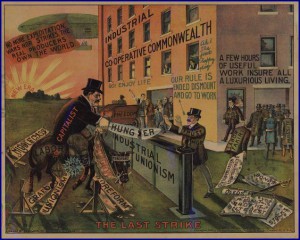Search the Blog
Categories
- Books & Reading
- Broadband Buzz
- Census
- Education & Training
- General
- Grants
- Information Resources
- Library Management
- Nebraska Center for the Book
- Nebraska Memories
- Now hiring @ your library
- Preservation
- Pretty Sweet Tech
- Programming
- Public Library Boards of Trustees
- Public Relations
- Talking Book & Braille Service (TBBS)
- Technology
- Uncategorized
- What's Up Doc / Govdocs
- Youth Services
Archives
Subscribe
Author Archives: Lynda Clause
Friday Reads: Sharp Objects by Gillian Flynn
I started r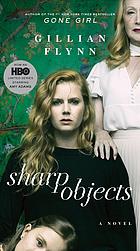 eading Sharp Objects after I started watching the HBO show. Gillian Flynn, the author, helped adapt the book for television, and I find more similarities than differences—though some of my friends who have been longtime fans of the book don’t agree with me. I think it’s the same story, told in different ways—like having a different relative go through a photo album with you, and hearing different details than you heard last time. This book and show illustrate effectively how there are different ways to tell stories, and some work better on the page, and some work better on the screen.
eading Sharp Objects after I started watching the HBO show. Gillian Flynn, the author, helped adapt the book for television, and I find more similarities than differences—though some of my friends who have been longtime fans of the book don’t agree with me. I think it’s the same story, told in different ways—like having a different relative go through a photo album with you, and hearing different details than you heard last time. This book and show illustrate effectively how there are different ways to tell stories, and some work better on the page, and some work better on the screen.
I could discuss the similarities and differences at length, but to focus on one aspect that won’t give too many spoilers—let’s talk about the roller skating. There are no roller skates in the book, but there is Camille’s first person narration (that, wisely, was not brought over to the show). Camille’s first person narration in the book tells us things that the roller skating shows us on the screen. The first episode opens with a flashback of Camille and her first younger sister skating outside of their small Missouri town. We can see Camille’s zest for life and freedom, her sister Marian trying to keep up, Camille keeping an eye on her. We see the setting is quiet enough for these girls to explore their environment in this innocent, edge of reckless, way.
By the time we get to the present-day of the story, the roller skates are on Camille’s second younger sister, Amma, and her two friends. (Trivia time: the actors playing her friends are sisters in real life, with a background in figure skating.) As viewers, we still align our point of view with Camille, as we do as readers—even though the show adds some scenes that aren’t from Camille’s point of view, the show is still from her worldview. Now the roller skates, on tween girls that aren’t Camille, serve a different purpose: these girls don’t stay in place long enough for most people to figure them out. They zip around their little town, risking their life (as the town police officer once points out) in traffic and without helmets, with all the vulnerability and invulnerability of the middle-schooler. From a strictly cinematic point of view, it’s uncanny: these characters are moving in a way that is out of pace with the other characters. The sound editing here is fantastic as well. Even if the dialogue was sometimes so quiet that mumbles and drawls had to replayed, the sound of the skates was rhythmic and insistent and yet natural—almost like the bugs would have sounded, in summertime Missouri, if the show had gone for real over surreal.
In later episodes, we see the roller skates one more time on Camille and once on another character—and each time we understand more about the wearer of the skates just because they’re wearing them.
We have this title in the Library Commission’s book club kits, and I’m surprised it’s not checked out right now. (Get on that, readers in Nebraska!) This would be a great book for a book club—lots of unexpected twists and turns, and unexpected and important topics, in a quick read. And your book group could discuss the show as well.
If you’re ready for more book vs. movie/television discussion, don’t miss our upcoming NCompass Live, Book vs. Movie: The Ultimate Showdown! online Wednesday September 12 at 10AM. (The archived session will be online, if that time doesn’t work for you.)
Flynn, Gillian. Sharp Objects: A Novel. , 2006. Print.
Noxon, Marti, creator. Sharp Objects. Crazyrose, Fourth Born, Blumhouse Television, Tiny Pyro, Entertainment One, 2018.
(This show is full of wonderful performances and film-making decisions that didn’t fall under the the topic of my blog post–Full cast and crew for Sharp Objects on IMDB)
Friday Reads: I’ll Be Gone in the Dark by Michelle McNamara
 Sometimes a book in your read-me-next list jumps to the front of the pack. I read the news reports like everyone else, a month ago, April 25, 2018—the Golden State Killer had finally been arrested. Over thirty years since his last likely murder, authorities arrested a suspect, 72-year-old Sacramento resident Joseph James DeAngelo, a former police officer, based on DNA evidence. I thought to myself: it’s time to read that book by Michelle McNamara, before I read anything else.
Sometimes a book in your read-me-next list jumps to the front of the pack. I read the news reports like everyone else, a month ago, April 25, 2018—the Golden State Killer had finally been arrested. Over thirty years since his last likely murder, authorities arrested a suspect, 72-year-old Sacramento resident Joseph James DeAngelo, a former police officer, based on DNA evidence. I thought to myself: it’s time to read that book by Michelle McNamara, before I read anything else.
I’ll Be Gone in the Dark: One Woman’s Obsessive Search for the Golden State Killer chronicles McNamara’s tireless research into the then-cold case of the serial killer (and rapist and burglar) that she dubbed the Golden State Killer, a moniker now solidified by recent media attention. While I’m not a true-crime buff, I am a lover of research and storytelling and problem-solving, and McNamara’s journey is thoughtfully told, somehow incredibly informative without ever being lurid or sensational. She never exploits or re-victimizes the people who had the misfortune to experience the mystifying, seemingly random violence of the Golden State Killer. The events in the book are not detailed chronologically from the Killer’s perspective, either, which would be more expected. This structure of the presentation of events seems to de-center and deflate the Killer, which is poetic, considering his need for control. Truly, this book is not really about him.
We read about his crimes in different geographic areas of law enforcement, between 1974 and 1986, and how different agencies put together that the crimes in their area might be committed by one offender. And then, occurring much later, we read how investigators realized how all these offenders (the East Area Rapist, the Original Night Stalker, the Visalia Ransacker, etc.) might be one extremely prolific criminal, that we now know as the Golden State Killer. McNamara details the protocols of investigations, and how they were changing, especially related to DNA collection and testing. She also did copious research herself, and interviews other researchers, amateur and professional, for a fascinating look into the minds of those who try to solve crimes.
McNamara died before she could complete the book. I didn’t know much about her or her writing career before she died. I was familiar with the work of her husband, Patton Oswalt, having enjoyed reading his books and watching his stand-up routines. McNamara was well-known in true crime circles for her blog TrueCrimeDiary, which focused on—you guessed it—true crime and cold cases, an interest she had ever since the unsolved murder of a teenager in her neighborhood as a child. When she died unexpectedly in 2016, McNamara had mostly completed the book, and had written many articles about the case and made extensive notes. The book was completed, faithful to its original intent, by a true crime writer she had worked with previously (Paul Haynes) and Oswalt. The editors have made it very clear what was written by her, what was transcribed from her notes and recordings, what was adapted from her published articles, and so on.
The book was released in February 2018, and it was the story of its posthumous publication that attracted me to it at first. Then HBO purchased the rights, and I was even more interested. And you already know what happened on April 25, 2018.
The title sounds like an odd choice, but when you read the chapter it comes from—a letter McNamara wrote to the Killer, about his eventual capture that she was certain would occur, written long before April 25,, 2018—you’ll understand why it was chosen for the title.
Of interest to library workers: using WorldCat as a research tool, on p 269, in a chapter called “The One.” In this engrossing chapter, we read about the “one” suspect on which various investigators each fixated, how they were each sure they had finally figured out who their suspect was, and then how all the different “ones” were ruled out. (Sidney, Nebraska is also mentioned on p 269—but don’t worry, just read the chapter.)
Also of interest to Nebraskans: the epigraph is a poem by Weldon Kees, “Crime Club.” It helps set an eerie tone for a book as much about the people solving a crime as it is about crime or a criminal. Sure, after you finish the book, you’ll probably want to dive into the news reports about Joseph James DeAngelo. (There’s plenty to read about him already, and more will come out when we get closer to a trial.)
But you might also take a little time to appreciate Weldon Kees. And look into the mystery of his disappearance, if you choose. Or just enjoy some of his poetry.
McNamara, Michelle. I’ll Be Gone in the Dark: One Woman’s Obsessive Search for the Golden State Killer. , 2018. Print.
Friday Reads: Malcolm X: A Life of Reinvention by Manning Marable
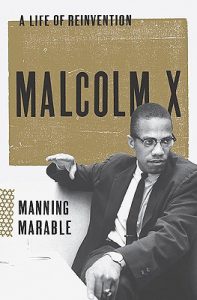 Today I’m writing about a book I’m not done reading yet, because I already know I can recommend it—especially to any Nebraskan who wants to know more than they (might have?) learned in school about Malcolm X.
Today I’m writing about a book I’m not done reading yet, because I already know I can recommend it—especially to any Nebraskan who wants to know more than they (might have?) learned in school about Malcolm X.
Manning Marable worked for years on “Malcolm X: A Life of Reinvention,” and it’s a book that combines extensive research with skillful storytelling and readability. Marable died shortly before the book was published in 2011. The book went on to win the Pulitzer Prize, and gathered both wide acclaim and bitter detraction.
It was a labor of love for Manning Marable, who was Director of Columbia University’s Institute for Research in African-American Studies (IRAAS), which is responsible for the The Malcolm X Project at Columbia University. Marable takes a more academic, yet still very readable, approach to the life of Malcolm X than the book you might already be familiar with, The Autobiography of Malcolm X, which was a collaboration between X and Alex Haley. If you’re not already familiar with that book, which came out in 1965 shortly after the death of Malcolm X, we have copies in our book club kit collection here, and it’s also recommended. It made the Nebraska 150 Books list.
Marable’s detractors fault him for being perhaps too eager to present details that the autobiography may have glossed over, enhanced, or simply left out. Each book has a different goal, to be sure, and to my mind it seems that the persona that is set forth in the autobiography was one that Marable accepted, and that he knew to be secure and strong in the minds of readers—and so his unexpected explorations are really a testament to his faith in the significance and consequence of Malcolm X as an individual. When you’ve centered so much of your professional life around someone’s legacy, as Marable did, especially when that someone is as complex as Malcolm X, appreciating and acknowledging that complexity is what separates dedication from devotion, or veneration from worship.
I can understand why such honesty might not seem refreshing, however, given the context of the current struggle for racial justice, whether it’s 1965, 2011, or 2018. There are plenty of other voices who can speak to this more eloquently and appropriately than I can. (I already have A Lie of Reinvention: Correcting Manning Marable’s Malcolm X [ed. Ball and Burroughs] checked out to read next, in order to better understand these objections.)
Of particular interest to Nebraskans, Marable’s book gives more context to the Omaha life of the family of Malcolm X than Nebraskans might know, and you’ll read disturbing details of KKK activity in Lincoln and Omaha in the early 1900s. This is a part of Nebraska history you also might not have learned about in school. To put that in some context, we’re coming up on the 100-year anniversary of the Omaha race riot of 1919, where a mob of white people stormed the Douglas County Courthouse and lynched a black man, Will Brown, awaiting trial for a crime he most likely did not commit. The mob also fatally wounded the Omaha mayor, Edward Smith. For more background on the event, see this recent addition to Nebraska Memories, and also this pdf from the Nebraska State Historical Society.
Marable, Manning. Malcolm X: A Life of Reinvention. New York: Viking, 2011. Print.
Posted in Books & Reading, General, Nebraska Memories
Tagged #FridayReads, Friday Reads, Malcolm X
1 Comment
Friday Reads: Important Artifacts… by Leanne Shapton

This is a story about a relationship coming together and then falling apart. It’s a very unusual book by Leanne Shapton, with a very long title: Important Artifacts and Personal Property from the Collection of Lenore Doolan and Harold Morris, Including Books, Street Fashion, and Jewelry.
The story is told through the format of an auction catalog, and items are presented in the order they would have mattered in the relationship—a pair of vintage salt and pepper shakers given as a gift, a pair of snowshoes worn on a winter vacation, leftover jars of homemade jam that the couple gave out as holiday presents. Often the items are accompanied by pictures of Lenore or Harold wearing or using the item. Some ephemera, such as opera programs or wedding invitations, bear scribbled conversations between the couple, and these are very telling. Also illuminating are the inscriptions inside the books given to each other as gifts.
Our characters have tastes refined enough to pass judgment on, without having to feel mean about it. These are the sort of things people buy selectively when they have more taste than money—shoes from Prada and Louboutin, toiletries from Chanel and Kiehl’s, clothes from Sonia Rykiel and John Galliano. Even the second-hand items are of good provenance—an Elsa Schiaparelli coat from a shop in Greece that someone may have said once belonged to the famous Maria Callas (someone else may have believed it—I’m reminded of the scene in Desperately Seeking Susan where the vintage shop owner tells Roberta that Susan’s jacket once belonged to Jimi Hendrix).
Each object could be expounded upon, so I’ll go for those porcelain poodles on the cover, given to Lenore by Harold. It’s been made clear in the book, previous to arrival of these dogs on page 68, that Lenore wants a dog—and that Harold doesn’t. Who thinks it’s cute to buy someone little dog figurines, as a gift, when that person really wants a real live dog, and might be thinking they’re actually going to get a dog for a present instead? Someone in touch with the recipient’s tastes but not their desires. Yes, a dog is horrible gift, and yes, Lenore had no reason to expect a dog was a possible gift. But I know how dog owners think, and it occurred to her that she was going to get a puppy as a present, and she would have taken that puppy as a good sign about their relationship. This is a good example, then, of what was wrong with this relationship: a couple that likes the same things (objects) but doesn’t love the same things (experiences, pursuits, achievements).
This is a very unique way to tell a story, especially a love story. It’s a comment on commercialism, on aspirational consumerism, on the expression of identity through objects. But beyond that, it’s engaging—we really do get a sense of these people, and we care about them, just based on photos and descriptions of their possessions.
Shapton, Leanne. Important Artifacts and Personal Property from the Collection of Lenore Doolan and Harold Morris, Including Books, Street Fashion, and Jewelry. New York: Farrar, Straus, and Giroux, 2009. Print.
Friday Reads: Bohemians: A Graphic History by Paul Buhle and David Berger
Bohemians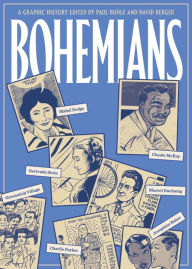 is an enjoyable, and flawed, collection of illustrated vignettes about influential people, places and times in the bohemian movement. Beginning in 1850s Paris, and ending in 1950s New York, several different graphic artists take a turn at telling part of the bohemian story. The variety of artistic styles keeps the eye interested, and many of the characters you already know are larger than life—Walt Whitman, Josephine Baker, Marcel Duchamp, Gertrude Stein, and Charlie Parker.
is an enjoyable, and flawed, collection of illustrated vignettes about influential people, places and times in the bohemian movement. Beginning in 1850s Paris, and ending in 1950s New York, several different graphic artists take a turn at telling part of the bohemian story. The variety of artistic styles keeps the eye interested, and many of the characters you already know are larger than life—Walt Whitman, Josephine Baker, Marcel Duchamp, Gertrude Stein, and Charlie Parker.
So what is a bohemian? The authors will give you many possible examples, but they will not give you an exact definition, which is appropriate considering that the movement itself encouraged disregarding boundaries and not letting life be limited by societal expectations. You could argue that free love and free thought were important to bohemians, but you’d want to remember those words meant something different in the Victorian era (and even in the United States of the 1950s), when rigid conformity was expected in society and relationships, even more so than today.
I read one review of this book by Joseph Donica in Journal of Graphic Novels and Comics that had this great line: “One rarely reads a book that disappoints on several levels and still decides to recommend that book to every likeminded reader he knows.” I think I like the book more than this reviewer, but I have reservations. I think advances in technology had a lot to do with the appeal of this movement—entertainment and communication were changing, and their influence on society can’t be underestimated. (This beginning of this era brings us the invention or accepted use of the telephone, the phonograph, the typewriter, and the camera.) Also, and this might be a critique more of the movement than the book—it’s easier for some people to reject society’s rules and still have a comfortable life, than it is for others. Class, race, and gender power structures still existed in the world, and sometimes the authors don’t give us this historical context—some bohemians sought freedom from, and some sought freedom to. But the stories are definitely enjoyable, and there’s enough of a variety that you’ll find plenty to appreciate even if not every story is to your liking. The graphic novel format works effectively in its portrayal of an array of places and times.
The authors prefer not to capitalize bohemian—perhaps to clearly separate the bohemian culture from the geographic area of Bohemia, which as Nebraskans (familiar with the “Bohemian Alps”) we know is a region of the Czech Republic. Incorrectly thought by nineteenth-century French dilettante historians to be the place of origin of the Romani people (sometimes known as “gypsy” people, a term now recognized as pejorative), the movement took the name because it found the Romani people’s “freedom” to be inspiring. This might seem strange to the modern reader, who knows that the Romani people were persecuted and impoverished, and later almost wiped out completely by the Third Reich. To think of their lives as “romantic” and “free” seems optimistic at best.
Buhle, Paul, and David Berger. Bohemians: A Graphic History, 2014. Print.
Friday Reads: The Grapes of Wrath, by John Steinbeck
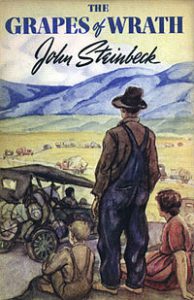 I recently re-read The Grapes of Wrath, and it felt so appropriate for today’s current events. My more experienced eyes were able to read the novel on more levels, as well. You know the story: Dust Bowl farm family sets off to California for the American Dream, but something has happened to the American Dream. There’s a wide cast of characters with realistic strengths and honest flaws, and we get the perspective of all of them over the course of the book—and they’re so frankly written, their desires so plainly stated, that we can easily identify with them—we’ve all been some part of some of these characters, at some points in our lives.
I recently re-read The Grapes of Wrath, and it felt so appropriate for today’s current events. My more experienced eyes were able to read the novel on more levels, as well. You know the story: Dust Bowl farm family sets off to California for the American Dream, but something has happened to the American Dream. There’s a wide cast of characters with realistic strengths and honest flaws, and we get the perspective of all of them over the course of the book—and they’re so frankly written, their desires so plainly stated, that we can easily identify with them—we’ve all been some part of some of these characters, at some points in our lives.
This time around, I was much more able to appreciate the unusual structure of the novel—the narrative chapters alternating with the more lyrical, prose-poem chapters. (Try reading any of the lyrical chapters aloud—you’ll be stunned by Steinbeck’s mastery of language when you feel yourself convey the words.) Steinbeck’s use of the form reinforces the timelessness of the tale—the narrative goes on in a familiar linear fashion, but it exists in a shifting, multi-dimensional framework outside of time, which is just as authentic as the narrative it contains, or the narrative that contains it.
There is no space between the author and what the author wants to convey to the reader—Steinbeck is not holding back, or affecting disaffection, in an effort to entice you. He does not play it cool for one second in this book. You will never doubt where his head is at. This earnestness could come off as preachy or strident in less capable hands, but I never had that experience with this book.
And Steinbeck’s earnestness, about the Joad family and what they are going through, about their moderate dreams, and about why they can’t achieve them, struck me as very relevant to today. The novel is set at the crossroads of economic, political and technologic times that resonate soundly today. Stuff you thought we’d have figured out almost a hundred years later, you know. The idea that farming and food production had become so successful, so advanced, and that people still didn’t have enough to eat—it was shocking then, and it’s shocking today. Today it’s not mechanized farming that we are trying to absorb and normalize, but other scientific advances—like GMOs, and the question of who owns the machines farmers use in their fields, and who gets to decide what to plant, to name just a few.
The novel also addresses the dynamic nature of populism, and how it can be used for the power of the people, and how it can be used to divide people and keep them down. The parallels between political leadership and religious leadership are easy to see in the character of the doubting preacher. And we read how religion can be used to bring comfort and encourage love and acceptance—and also how it can be used as a tool to control others, or even to our own disadvantage.
You can see why the book won a Pulitzer Prize. (The Pulitzer is celebrating its 100th birthday this year, by the way.) Also by the way: we have this book in our book club kits, so if you’re in Nebraska, your library can check this book out for your book club. You’ll have some good discussions, I promise. Definitely last, but definitely not least in your discussions—what is up with that ending? There are a lot of ways to interpret it. It would be interesting to hear what different people in the group think about it.
I’ll sign off with an audio clip from YouTube of Woody Guthrie singing “Tom Joad,” because why not.
(There are a few other musicians with songs about Tom Joad—the character seems to have really struck a chord with pop culture. It’s a fun search to try and find all the songs.)
Steinbeck, John. The Grapes of Wrath. New York: Penguin, 2002. Print.
Friday Reads: The Strange Library by Haruki Murakami
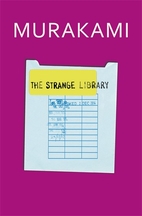 Because Haruki Murakami’s birthday was yesterday, and because this is a library blog, this week I’ve chosen to write about The Strange Library by Haruki Murakami. While this is available as an audio book, I must recommend the Knopf print edition if you are able to read that instead. The book design is by Chip Kidd, and it’s lovely. The cover alone references the narrative in several creative ways, and the illustrations within the book are plentiful and thoughtful.
Because Haruki Murakami’s birthday was yesterday, and because this is a library blog, this week I’ve chosen to write about The Strange Library by Haruki Murakami. While this is available as an audio book, I must recommend the Knopf print edition if you are able to read that instead. The book design is by Chip Kidd, and it’s lovely. The cover alone references the narrative in several creative ways, and the illustrations within the book are plentiful and thoughtful.
The art design struck me even more as a vehicle for the story, a vehicle almost approaching a translation of the story, because of a recent article about Murakami. If you’re interested in Murakami, you should read “The Murakami Effect” by Stephen Snyder, which appeared on Literary Hub on 01/04/2017. You may agree or disagree with the writer’s arguments (here’s a clue to its contents: the subtitle is “On the Homogenizing Dangers of Easily Translated Literature”), but reading a critique of the translation of Murakami’s work does give you an insight into how the author structures his works. Murakami does not write about complicated ideas as much as he juxtaposes unexpected, easily visualized entities and actions, which allow the reader to fill in the complicated ideas themselves, around those entities and actions. This happens to make him very easy to translate—or, he writes this way because it’s easy to translate, according to Snyder.
I have more of an appreciation for Murakami after reading the Lithub article, which may not have been the author’s intent. Snyder attempts to take some wind out of the literary sails of Murakami’s reputation, comparing him to other Japanese writers (like Minae Mizumura, whom you might want to learn more about) and finding him, in the end, pop.
But I like pop. Murakami is nuanced enough to be quality while being accessible. And letting the reader draw some conclusions is one of my favorite things that an author can do—I love this about Flannery O’Connor, for example. It is important, though, not to take Murakami’s work as any sort of object lesson about Japanese life, just as we can’t expect to learn all we need to know about the South from O’Connor. This is another point in Snyder’s article—how Americans see Murakami’s writing as synecdochical for all things Japanese, overwriting reality with a magic key they think they learned from some magical realist novels. Readers need to try to be smarter than that, and I think we can be.
The Strange Library is a quick read—for a less marketable author, this would have just been a short story in a magazine. So hipster grad students won’t be able to carry it around as long as they can carry around their copies of 1Q84… but it’s a good introduction to Murakami if you’ve been interested and yet haven’t taken the leap. And you know you want to read a book called The Strange Library. And yes, that’s all I’m going to tell you about the actual text.
Fun facts about Haruki Murakami: not related to writer Ryu Murakami (whom I recommend if you want something grittier) or artist Takashi Murakami (if you want something even more pop). And if there’s anything more precious, predictable, and yet still enjoyable, than a McSweeney’s humor piece about Haruki Murakami, I don’t know what it would be, so here that is.
Murakami, Haruki, and Ted Goossen. The Strange Library: 107. , 2014. Print.
Friday Reads: Frankenstein, by Mary Shelley
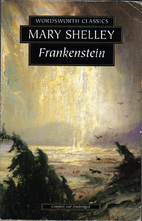
Frankenstein is a remarkably modern book that’s just shy of its bicentennial birthday. Often called the first science fiction novel, it’s a parable for how mastering technology (and the pursuit of knowledge and success that comes along with that) can ruin us if we don’t keep our goals in perspective. Mary Shelley manages to warn us to remember to keep things in balance—without ever coming across as anti-modern or anti-technology. (And she wrote this when she was a teenager—there’s your real Halloween scare.)
Sure, you may have been required to read Frankenstein in high school. You’ll get a lot more out of it when you read it as an adult, trust me. First of all, the structure of the narrative is totally bonkers—it should not work, but it does. I can tell you this without giving away any spoilers: One character is telling his story and another character’s story (and that second character is telling the story of some other characters) and it’s all wrapped up in the narration of yet another character, who is in the middle of writing letters about the whole story he’s hearing—along with his own story. It’s a nesting doll structure that any writer would be wary to imitate. The heavily mediated structure helps illustrate the isolation being experienced by most of the main characters, and at the same time, lends the story an authenticity—a feeling that this may really have happened.
Reading Frankenstein as an adult also allows the reader a lot more insight into what motivates the characters… as well as some skepticism about whether they’re really coming clean with each other. You’ll enjoy giving it a second (or a first) chance.
Frankenstein is available to you in many editions and from many avenues. (Here at the Nebraska Library Commission we even have it as one of our book club kits.) Two common editions are from 1818 and 1831—I’d recommend the 1818 edition myself. Because of the age of the text, it’s available in the public domain, and the Internet Archive has a few editions to choose from. You can also listen to a free audiobook from Librivox here and here, and those are only a couple of the audio versions they have available.
Happy Halloween… and remember, don’t go out there and create your own worst nightmare!
Shelley, Mary W, and Marilyn Butler. Frankenstein, Or, the Modern Prometheus: The 1818 Text. Oxford: Oxford University Press, 2008. Print.
Friday Reads: Brain on Fire, by Susannah Cahalan
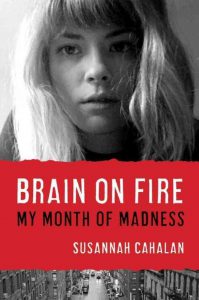 Brain on Fire: My Month of Madness is a medical memoir that may have caught your eye on library shelves—an attractive young woman on the cover, an author’s name spelled in a way that patrons (and maybe even staff) would search for incorrectly—it’s Susannah Cahalan, not Callahan. You’ll see buzz about it again soon, because a movie based on the book is in post-production—starring Chloe Grace Moretz.
Brain on Fire: My Month of Madness is a medical memoir that may have caught your eye on library shelves—an attractive young woman on the cover, an author’s name spelled in a way that patrons (and maybe even staff) would search for incorrectly—it’s Susannah Cahalan, not Callahan. You’ll see buzz about it again soon, because a movie based on the book is in post-production—starring Chloe Grace Moretz.
Brain on Fire is the compelling tale of a young professional who exhibits disturbing behavioral symptoms, which are easily misdiagnosed by medical professionals looking for horses instead of zebras. Their incorrect diagnoses lead to treatments that do more harm than good. Cahalan’s symptoms seem to suggest mental illness, which doctors are eager to label her with since she’s a young woman in a stressful profession. One doctor is sure she’s “partying too much.” But the truth is more complicated, because her brain and body are in battle with each other. She has a rare autoimmune disease, only recently discovered. It’s only because of Cahalan’s tenacity that she keeps searching for better treatment—and she knows that’s she’s lucky to have the skills to advocate for herself, and to be able to find a doctor current enough on research to be able to see the real problem. Not every person with the illness would be so fortunate. (This is where the reader gets scared, if they aren’t already frightened by the author’s symptoms which are reminiscent of Friedkin’s Exorcist.) Her family is a big part of her confidence, and her recovery, and she writes about them with compassion and honesty. Getting to the correct diagnosis is the first half of the journey—then the treatment and recovery are dramatic as well, and will keep you turning the pages.
Brain on Fire is different from other examples of the popular genre of medical memoir because it’s not written by a medical professional (where, suddenly, their field is humanized for them) or by a complete layperson (where the author is at first lost in jargon but comes to an understanding about their disease). Our author, Susannah Cahalan, is an up-and-coming investigative reporter at the New York Post at the beginning of the book, and she uses her journalistic skills both to research her illness and to describe her journey through her illness. Her disease takes away her ability to work, and her career is very important to her. This book is her way of showing her chops in her field—she wants to prove she’s ready to get back in the game of newspaper work. Writing the book is an act of redemption for Cahalan—a way to illustrate that she has her identity and ability back. Cahalan also co-wrote the movie screenplay with director Gerard Barrett (who’s helmed gritty Irish dramas Pilgrim Hill and Glassland). The author’s perspective on her illness and her life make this medical memoir cross over into a coming-of-age story—a young woman fighting to establish her place in the world, and in her own life, and even in her own body and mind.
I’d recommend Brain on Fire to medical memoir fans, and the New Adult/Mature YA reader. It is a surprisingly quick and attention-grabbing read for a heavy topic, so it’s a good plane read as well. You might think that since Cahalan was a reporter for the New York Post that the book would have a “Man Bites Dog” tone to the narrative—I was hesitant about the book for that reason at first, but I was pleasantly surprised by her enjoyable style. The tone is approachable and authentic, like an especially engrossing magazine article; but it’s still written with the authority of a piece that’s been thoroughly fact-checked. No one’s going to come back and tell you it was boring.
Cahalan, Susannah. Brain on Fire: My Month of Madness. New York: Free Press, 2012. Print.
Friday Reads: The Fishermen, by Chigozie Obioma
 Chigozie Obioma’s book, The Fishermen, is one of those novels that’s perfect for book groups or for individual reading, because you can feel through it, or think through it, or both. This compelling page-turner has characters that the reader will be emotionally invested in, but it’s also a novel that’s good for discussion for groups who want to take more time with the unpacking. It’s a good recommendation for the reader wanting a straightforward narrative, as well as the reader looking for symbolism, mythic undertones, and classic themes, all written with a fresh voice.
Chigozie Obioma’s book, The Fishermen, is one of those novels that’s perfect for book groups or for individual reading, because you can feel through it, or think through it, or both. This compelling page-turner has characters that the reader will be emotionally invested in, but it’s also a novel that’s good for discussion for groups who want to take more time with the unpacking. It’s a good recommendation for the reader wanting a straightforward narrative, as well as the reader looking for symbolism, mythic undertones, and classic themes, all written with a fresh voice.
The story is set in 1990s Nigeria, and our narrator is Benjamin, one of four young brothers in a loving family. When their father’s job takes him to another city away from the family home, the brothers must navigate growing up and being young, with each other as role models. Their relationship with their mother is strong, and tender, but they want to grow up as much as they want her acceptance and affection. After a man in their town makes a prediction about their future, their love is tested—and there is a battle of wills, within and among the brothers, to see if the prophecy can be ignored.
Because the story is from a child’s point of view, you don’t need have any previous knowledge about Nigeria or the 1990s in order to enjoy the book. Some details of the story might inspire you to do more research, but all the reader needs to know is in the book. The author includes a few words of the vernacular languages, but the meanings of those words are clear from the context. The themes of the story would work whether the setting was Nigeria or Nebraska: how much we can love and despise our siblings, how mistakes made by the people we look up to can shake our security in the world, and how the sacrifices parents make for their children are often misunderstood by those children.
The Fishermen was shortlisted for the 2015 Man Booker Prize for Fiction, and received glowing reviews from the New York Times, here; and The Guardian, here; and from many other publications. The author is currently living in the United States and teaching at the University of Nebraska.
Friday Reads: Cinderella Ate my Daughter by Peggy Orenstein

Cinderella Ate My Daughter
by Peggy Orenstein
Have you ever noticed the increased abundance of princesses and pink in the youth section? Have you ever wondered how that came about?
Peggy Orenstein is an accomplished writer and cultural critic. When she has a daughter, she hopes to offer her a positive childhood experience that doesn’t revolve around her daughter being pretty or a “princess.” What she encounters is a consumer culture very different than the one she grew up in—and one that has surprising appeal for her daughter.
Orenstein takes a personal approach to the story, and her desire for her daughter’s happiness—even if it doesn’t look like the happiness she imagined for her—gives the book a very balanced and nuanced tone about complicated topics. Even when she visits a toddler beauty pageant, she doesn’t judge the families that are involved, but she does present an unvarnished look at the mechanics and effects of the child beauty industry. She writes honestly about moments when she doesn’t handle her frustration well—like when her four-year-old wants hyper-sexualized “bratty” doll/action figures on their trip to the store. In that sense, it’s a classic story of a child and a parent having different ideas about identity—and the parent having to learn how to let their child have their own ideas, in the safest environment they can provide.
What really stuck with me was the description of the processes companies use to market to children. You won’t forget the story about the branding shift at Disney, when the new head of the consumer products division realized that the firm demarcation between Disney vehicles—which was designed to protect narrative integrity—was getting in the way of selling products. Or his moment of clarity at a Disney on Ice show, when he realized all the little girls in the audience were wearing homemade costumes—and how his company could change that.
My paperback copy is covered with accolades and blurbs, and I like that People called the book “Funny,” while Vanity Fair called it “Blood-Chilling.” I read this as an assigned book for a class, but I’d recommend it to anyone who has children, or who works with children—or anyone who is curious about generational differences in attitudes towards gender and consumerism.
Orenstein, P. (2011). Cinderella ate my daughter: Dispatches from the front lines of the new girlie-girl culture. New York, NY: HarperCollins.
Friday Reads: The Haunting of Hill House by Shirley Jackson
The Haunting of Hill House tells us the story of Eleanor an d her visit to Hill House, where she has been invited to take part in the exploration of its possible haunting. Eleanor is in a bad place in a sad life as she travels to the house—she has been the caretaker for her recently deceased mother, and her remaining family is caught up with their own busy lives, and they don’t seem to care about her health or well-being. At Hill House, she meets colorful characters she never would have met otherwise. There is Dr. Montague, who wants to scientifically quantify any eerie occurrence they find, to finally connect science and the supernatural. There is Theodora, who is a free spirit who seems to have figured out a lot of things about life that continue to baffle Eleanor, but who still doesn’t have all the answers. And there’s Luke, who will inherit Hill House someday, and all the baggage the house represents—and symbolizes. The group of psychic adventurers has to work out their interpersonal dynamics with each other and with newcomers.
d her visit to Hill House, where she has been invited to take part in the exploration of its possible haunting. Eleanor is in a bad place in a sad life as she travels to the house—she has been the caretaker for her recently deceased mother, and her remaining family is caught up with their own busy lives, and they don’t seem to care about her health or well-being. At Hill House, she meets colorful characters she never would have met otherwise. There is Dr. Montague, who wants to scientifically quantify any eerie occurrence they find, to finally connect science and the supernatural. There is Theodora, who is a free spirit who seems to have figured out a lot of things about life that continue to baffle Eleanor, but who still doesn’t have all the answers. And there’s Luke, who will inherit Hill House someday, and all the baggage the house represents—and symbolizes. The group of psychic adventurers has to work out their interpersonal dynamics with each other and with newcomers.
Jackson’s novel is a quick read of, as Dorothy Parker says in the blurb on the back, “beautifully written, quiet, cumulative shudders.” The text can be enjoyed as a breezy distraction, or there are plenty of plot points to reflect upon if the reader wishes. For example, Eleanor has been invited to the house by Dr. Montague because of a psychic experience as a child—what does it mean to have been a “special” child who grows up to be an adult that seems quite ordinary? How much can we rely on childhood memories and how do they affect us? How do we use memories to reconstruct traumatic family events?
This is one of those stories that will have you questioning what the characters believe—and will inspire you to think about what is really frightening in life. Ghosts? Loneliness? Bad architecture? Home ownership? Letting someone else do your thinking for you?
The Haunting of Hill House is a great example of the female gothic novel, where issues affecting women are explored through the themes of gothic literature. These themes include the influence of place, power dynamics, our struggle to reconcile logic with nature, and the reliability of memory, among other interesting issues.
This novel was adapted to make the 1963 movie The Haunting, which is enjoyably stylish but less nuanced than the novel. (The movie was remade in 1999 with an impressive cast and poor result.) Shirley Jackson is also the author of many other novels and stories, including “The Lottery,” which you may have had to read in school. If you already appreciate Shirley Jackson, you might enjoy this quiz: http://the-toast.net/2015/04/20/how-to-tell-if-you-are-in-a-shirley-jackson-story/
New Online Archive of Historical Political Posters
If you like archives of historical images, you’ll enjoy this newly-available collection of them from the University of Michigan’s Labadie Collection. It features striking political posters from many cultures. A great resource for the researcher, armchair historian, politico, or graphic art fan.
Read the university’s description of the archive here.
More details about the picture above are here.
Posted in General
Leave a comment
